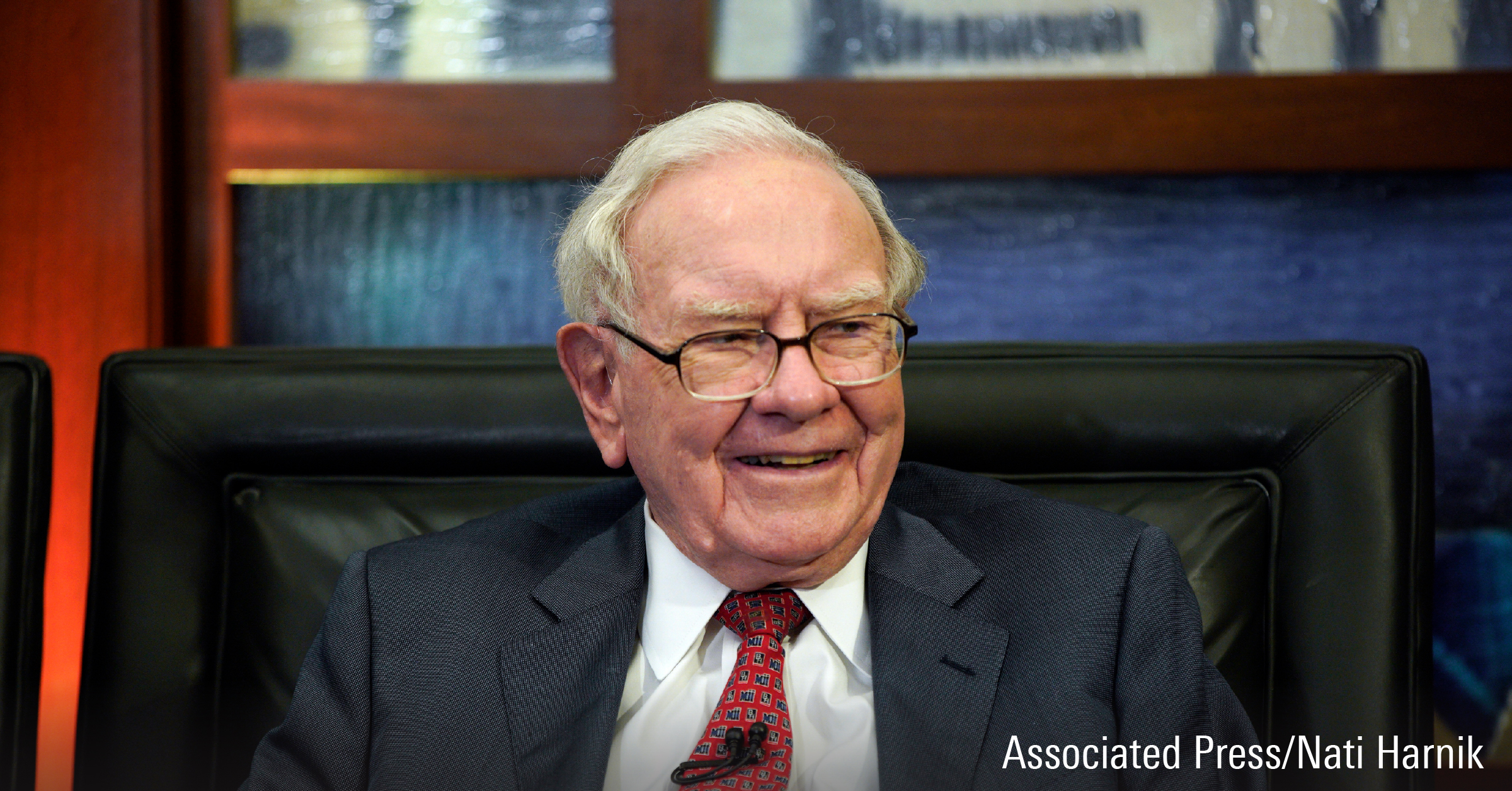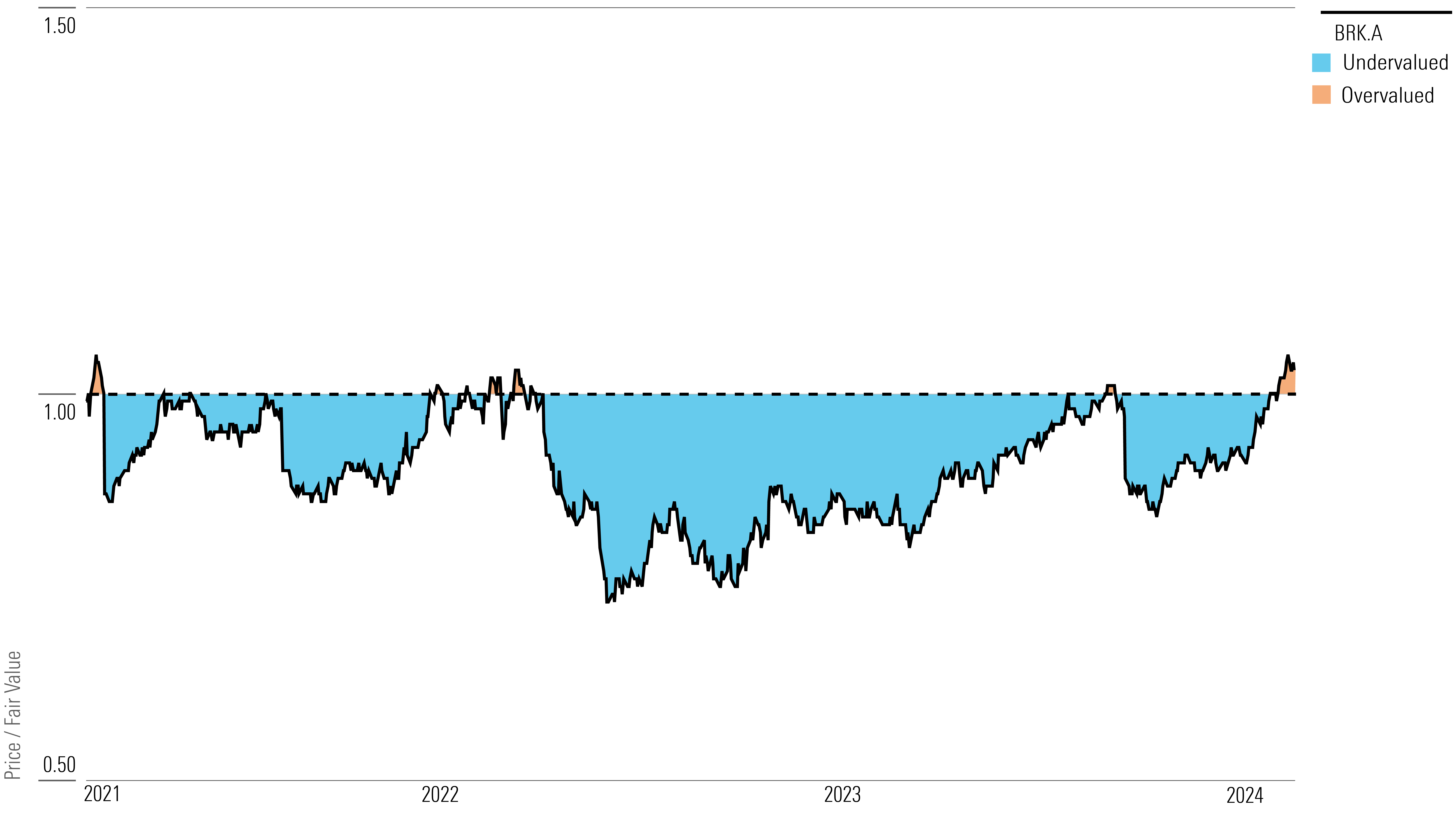After Earnings, Is Berkshire Hathaway Stock a Buy, a Sell, or Fairly Valued?
With an increase in insurance profitability but declines elsewhere, here’s what we think of Berkshire Hathaway’s stock.

Berkshire Hathaway BRK.A/BRK.B released its fourth-quarter earnings report on Feb. 24. Here’s Morningstar’s take on the earnings and overall outlook for Warren Buffett’s company.
Key Morningstar Metrics for Berkshire Hathaway
- Fair Value Estimate BRK.A: $600,000.00
- Fair Value Estimate BRK.B: $400.00
- Morningstar Rating: 3 stars
- Morningstar Economic Moat Rating: Wide
- Morningstar Uncertainty Rating: Low
What We Thought of Berkshire Hathaway’s Q4 Earnings
Berkshire’s insurance unit had a big year. Not only were underwriting profits solidly in the black (reaching $6.9 billion, its best showing ever), but the company also saw a 49.9% increase in pretax investment income (to $11.6 billion, mainly on the backs of increased investments in T-Bills, which have been yielding more than 5% for much of the past year).
Geico continues to recover along with the rest of the US personal auto industry. The company remained solidly in the black during the fourth quarter and the full year, as it increased pricing by close to 17% in 2023, which decreased its policies in force by around 10% but improved its loss ratio to 76.9% (81.0% for the full year) during the fourth quarter from 93.1% in the year-ago period.
While the Alleghany deal boosted earned premium growth at Berkshire Hathaway Reinsurance Group and Berkshire Hathaway Primary Group during 2023, price hardening and a lack of significant catastrophe losses also drove underwriting profits to record levels. Catastrophe losses crept back in during the fourth quarter, but they were still just $2.8 billion for the full year compared with $3.5 billion in 2022 ($1.9 billion of which was tied to Hurricane Ian). As a result, BHRG posted an underwriting loss of $591 million for the December quarter and a profit of $1.9 billion for the full year, aided somewhat by the inclusion of results for the acquired Alleghany operations.
BNSF Railway and Berkshire Hathaway Energy had off years. These two noninsurance operations usually offer a more diversified stream of revenue and pretax earnings, helping offset weakness in the insurance business (especially over the past 15 years, when cash yields were near zero and underwriting profitability was inconsistent). It was the complete opposite in 2023, as substantially improved results from the insurance operations more than made up for less-than-stellar results from BNSF and BHE.
Normally a pillar of stability, BHE reported a 4.3% decline in fourth-quarter revenue and a 1.5% decline in the full year on a preliminary basis. The real estate operations at Berkshire Hathaway HomeServices had negative effects of 4.6% and 18.0% declines in revenue, respectively, as well as weaker results from some of its regulated utilities. These factors contributed to a decline to $940 million in 2023 from $3.1 billion in the year-ago period in preliminary pretax earnings. BHE also contended with an increase in energy operating expenses, including increases in estimated pretax loss accruals by PacifiCorp for wildfires (net of expected insurance recoveries) of $1.6 billion during 2023, plus higher interest expense and lower electric utility margin year over year.
We view this as a blip in BHE’s overall results. We continue to believe ongoing constructive rate-case outcomes will lead to EBITDA growth in an average 5%-6% range annually over the next five years for its regulated US utilities, even as it ramps up growth and operating capital expenditures. We think the residential real estate and brokerage business will eventually recover from its recent lows as rates decline some over the next several years.
Berkshire’s cash balances once again topped $150 billion, and we continue to be less concerned than we thought we would. The firm closed out December 2023 with a record $167.6 billion in cash and cash equivalents, up from $157.2 billion at the end of September 2023. Owing to a lack of viable investment opportunities, unutilized free cash flow left cash balances firmly above the $150 billion threshold that CEO Warren Buffett has claimed would be difficult to justify as untenable to shareholders.
We have been less concerned about this issue than we anticipated so far, primarily because short-term rates are above 5% and Berkshire had $129.6 billion invested in T-bills at the end of December 2023. Of the $167.6 billion in cash and cash equivalents on Berkshire’s books at the end of the fourth quarter, the insurance and MSR divisions held $163.3 billion, comprising $129.6 billion in T-bills and $33.7 billion in cash.
Share repurchases remain muted. We also note that Berkshire’s recent share repurchase activity continues to underwhelm, as it amounted to $2.2 billion worth of stock in the fourth quarter and $2.1 billion on average over the past six calendar quarters, compared with $6.5 billion on average quarterly during 2020-21. However, this is understandable, given that the company’s shares have traded close to our fair value estimates for much of that time.
As long as valuations are still inadequate for the publicly traded and privately held firms that Berkshire prefers to acquire or invest in (making acquisitions and stock investments all that much harder to enact), the company seems to be kind of stuck with share repurchases as its primary option for working down cash balances, especially with dividends off the table.
Berkshire Hathaway Stock Price
Fair Value Estimate for Berkshire Hathaway
With its 3-star rating, we believe Berkshire stock is fairly valued compared with our long-term fair value estimate. We’ve increased our fair value estimate to $600,000 per Class A share from $555,000 after updating our forecasts for the company’s operating businesses and insurance investment portfolio.
Our new fair value estimate is equivalent to 1.43 times our estimate for Berkshire’s book value per share at the end of 2024 and 1.32 times for 2025. For some perspective, during the past five (10) years, the shares have traded at an average of 1.40 (1.43) times trailing calendar year-end book value per share. We use a 9% cost of equity in our valuation and assume Berkshire pays a minimum of 15% corporate alternative minimum tax on adjusted financial statement income for taxable years beginning in 2023.
Our fair value estimate is derived using a sum-of-the-parts methodology, valuing each of Berkshire’s operating segments separately and then adding them together. After revising our projections for 2023-27, we have increased our valuation for Berkshire’s insurance operations to $297,000 per Class A share from $257,500, owing primarily to adjustments we’ve made to earned premium growth, underwriting profitability, and returns and overall yield on the investment portfolio.
Our forecast assumes Berkshire generates earned premium growth (including the Alleghany acquisition) of 9.2% on average annually during 2023-27, compared with 4.3% during 2018-22, with the insurance operations overall posting an average annual combined ratio of 97.0% (an improvement from 98.6% on average during 2018-22 as Geico improves its loss ratios). We also expect the insurance investment portfolio (including market gains/losses and additional investments) to expand at an 11% compound annual growth rate during our projection period.
Read more about Berkshire Hathaway’s fair value estimate.
Berkshire Hathaway’s Historical Price/Fair Value Ratio

Economic Moat Rating
We’ve historically believed that Berkshire’s economic moat is more than just the sum of its parts, although those parts are fairly moaty on their own. The insurance operations—Geico, BHRG, and BHPG—remain important contributors to the overall business. Not only are they expected to account for around 30% of Berkshire’s pretax earnings (and 50% of our valuation of the firm), but they are also overcapitalized (maintaining a larger-than-normal equity investment portfolio for a property and casualty insurer) and generate low-cost float.
These temporary cash holdings, which arise from premiums collected in advance of future claims, have let Berkshire generate additional returns as the company invests these funds in assets that are commensurate with the duration of the business being underwritten. They tend to come at little to no cost to Berkshire, given its proclivity for generating underwriting gains over the past several decades.
That said, we don’t believe the insurance industry is particularly conducive to maintainable competitive advantages. While there are some high-quality firms (with Berkshire having some of the best operators in the segments where it competes), their product is basically a commodity, and it’s difficult to consistently achieve excess returns. Buyers of insurance are not inclined to pay a premium for brands, and the products themselves are easily replicable. Competition is fierce, and participants have been known to slash prices or undercut peers to gain market share. Insurance is also one of the few industries where the cost of goods sold (signified by claims) may not be known for years, incentivizing companies to sacrifice long-term profitability for near-term growth. In reinsurance, this dynamic can be even more pronounced, as losses in this business tend to be large and may not be realized for many years after a policy is written.
That said, insurers can develop maintainable cost advantages by either focusing on less-commodified areas or developing efficient and/or scalable distribution platforms. But they can’t gain a maintainable competitive advantage through investing, even when gains are the result of the investing prowess of someone like Warren Buffett. We believe insurers that consistently achieve positive underwriting profitability are better bets in the long run, as insurance profitability tends to be more maintainable than investment gains and income.
Read more about Berkshire Hathaway’s economic moat.
Risk and Uncertainty
Our Uncertainty Rating for Berkshire is Low. We don’t currently consider any of the firm’s environmental, social, or governance issues material enough to affect our rating, primarily due to its lower exposure to some of the main risks inherent to the industries where it competes. However, Berkshire has generally scored lower on governance issues because of the makeup of its board and board committees, the unequal voting structure of its shares, and its historical lack of engagement and opaqueness on governance issues.
Berkshire faces the risk that insurance claims exceed loss reserves or that material impairments affect its investment portfolio. Several of the firm’s key businesses—insurance, energy generation and distribution, and rail transport—operate in industries that are subject to higher degrees of regulatory oversight, which could affect future business combinations and the setting of rates charged to customers. Many of the company’s noninsurance operations are exposed to the cyclicality of the economy, with results suffering during slowdowns.
Read more about Berkshire Hathaway’s risk and uncertainty.
BRK.A/BRK.B Bulls Say
- Book value per share (a good proxy for measuring changes in Berkshire’s intrinsic value) increased at an estimated 18.3% CAGR in 1965-2022, compared with a 9.9% annualized return for the S&P 500 TR Index.
- Berkshire’s stock performance has generally been solid, increasing at a 9.5% (13.3%) CAGR during 2018-22 (2013-22), compared with a 9.4% (12.6%) average annual return for the S&P 500 TR Index.
- At the end of June 2023, Berkshire had approximately $166 billion in insurance float. The cost of its float has been negative for much of the past two decades.
BRK.A/BRK.B Bears Say
- Given its size, Berkshire’s biggest long-term hurdle will be its ability to consistently find deals that not only add value but are also large enough to be meaningful.
- Another big issue facing the firm is the longevity of chair and CEO Warren Buffett, who turned 93 at the end of August 2023. Meanwhile, longtime managing partner Charlie Munger died in November 2023.
- Berkshire’s insurance business faces competitive and highly cyclical markets that occasionally produce large losses, and several of its noninsurance operations are economically sensitive and focused on US markets.
This article was compiled by Quinn Rennell.
The author or authors do not own shares in any securities mentioned in this article. Find out about Morningstar’s editorial policies.


/cloudfront-us-east-1.images.arcpublishing.com/morningstar/GJMQNPFPOFHUHHT3UABTAMBTZM.png)
/cloudfront-us-east-1.images.arcpublishing.com/morningstar/ZYJVMA34ANHZZDT5KOPPUVFLPE.png)
/cloudfront-us-east-1.images.arcpublishing.com/morningstar/LDGHWJAL2NFZJBVDHSFFNEULHE.jpg)